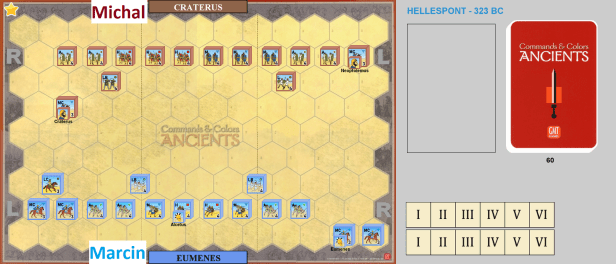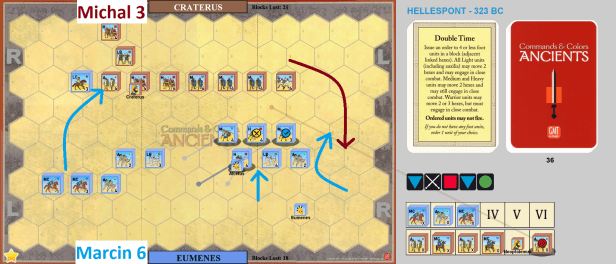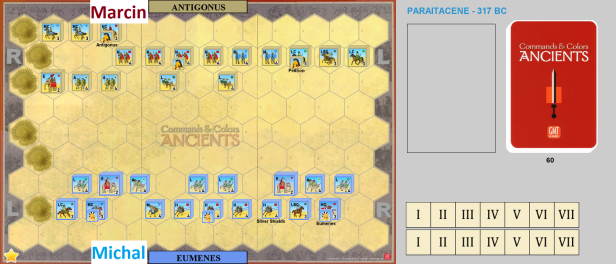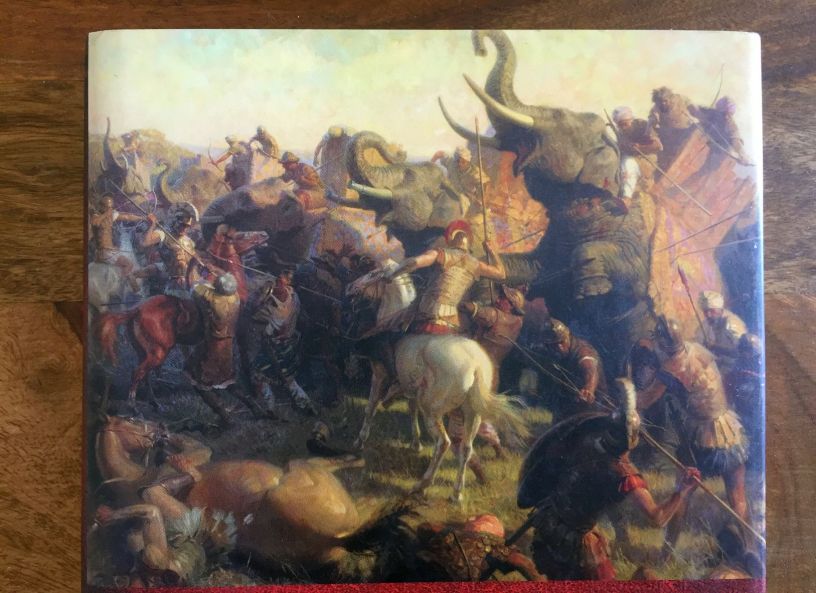Since the time I read Dividing the Spoils by Robin Waterfield I am fascinated with Alexander’s Successors period. What was going on there was a true struggle of competent and equal enemies over the world hegemony. Battles fought then were on ground breaking scale and campaign taken by Ptolemy, Eumenes or Antigonus – with almost unprecedented breadth and depth. It is thus a pity that such a glorious period is a little obscure and to a great extent overshadowed by the Alexander the Great.
Still, the conflicts fought then make for a perfect wargaming experience. Tons of elephants in many battles, phalanx at its height, great cavalry, combined arms tactics – you can really immerse yourselves in the period. With Marcin we decided to play four main engagements of the epoch – due to isolation, it was still via superb Vassal module. And the game we have chosen was our favorite Commands Colors Ancients.
Below I am representing short historical backgrounds (after commandsandcolors.net), forces disposition and main actions on the battlefield. Enjoy!
Hellespont (323 BC)
Historical background
Alexander’s death in 323 BC threw his empire into a state of political and military turmoil, with his generals and governors calming independent kingdoms as his “Successors” (the Diadochia). Perdiccas inherited the main Macedonian army and the title ‘regent of the Asiatic Empire.’ A coalition of other successors formed against him. An army under Craterus was sent to Asia to confront Perdiccas and his allies. Perdiccas sent Eumenes and Neoptolemus with an army to the Hellespont to prevent Craterus from crossing into Asia.
Neoptolemus, jealous of Eumenes, deserted with a few hundred horse and joined forces with Craterus. After crossing, when Craterus and Eumenes met, each had around 20,000 infantry but Craterus’ phalanx of veteran Macedonians was superior. Eumenes relied on his more numerous cavalry. Both sides stationed their phalanx in the center and cavalry on the wings.
Craterus, commanding the right wing, charged at the onset. He was slain, and his cavalry scattered. On the other wing, Neoptolemus confronted Eumenes, and in single combat, Neoptolemus was killed. Craterus’ infantry, by now surrounded and leaderless, surrendered. Eumenes invited the defeated Macedonians to join him. They agreed, but took off by night to rejoin Antipater, the regent of Greece and Macedonia.
The Battle of the Hellespont removed two contenders, but the War of the Successors would go on for another 40 years.
Report

- First things first – I retreated back with Craterus not to duplicate what historically happened to him (he died at the beginning of battle)
- Maricn slowly moved his center but then his wings started to dangerously approach mine!
- Then he attacked on both sides; on my right I was not able to do anything but on the other side Marcin’s forces were countered with surprising Mounted Charge. Eumenes barely survived and I got all my points there.
- That was unfortunately all what Craterus army could present on that day; Double Time in center finished the game without my heavy troops ever being engaged

Try as I might, I was not able to crush Eumenes forces. I was lucky on my left but other than that that was slow grinding of my forces until they broke. I lost twice as much blocks which evidently reflected what was going on.
Paraitacene (317 BC)
Historical background
By 318 BC the Successors had formed two competing alliances: the ‘Royalists’ who claimed to fight to maintain the empire for Alexander’s infant sons, and a rival coalition that sought to claim their own independent kingdoms. The opposing Successor Armies in Asia—one command by Antigonus, the other by Eumenes—met in battle at Paraitacene in 317 BC.
Antigonus was by now the most powerful of the Diadochi, controlling most of Anatolia and the eastern satrapies. Eumenes had the backing of Alexander’s heirs and a large war chest, though the fact that he was a Greek and not a Macedonian was a major handicap.
Antigonus fielded 28,000 infantry and 11,000 horse. Eumenes’ force of 35,000 foot and 6,000 horse included the veteran Silver Shields who had fought with distinction in all of Alexander’s campaigns. The battle opened with Antigonus’ light horse attacking Eumenes right. This attack was wrecked by Eumenes’ heavy cavalry. Meanwhile in the center, the Silver Shields drove back Antigonus’ phalanx. Antigonus’ army was on the ropes when he pulled off a stroke that evened the score. He charged through a gap and was successful in routing Eumenes’ left flank. Both sides at this point were exhausted and returned to their camps. The battle was a draw.
Report

- That was exciting game; we slowly approached each other…
- …and then the whole hell was loosed! The biggest clash ensued on my left / Marcin’s right where elephants, heavy and medium cavalry were killing each other in droves. In the end barely any forces survived there…
- …but that gave my phalanx time to approach in the center and strike a definite blow. Supplemented by quick and deadly mounted advance on my right, that finished the game

I think that was my best performance in all four games played. Marcin’s forces were utterly defeated and Antigonus fled from battlefield 🙂
Gabiene (316 BC)
Historical background
After Paraitacene in 317, Eumenes was desperately trying to keep the united Empire of Alexander alive for his heirs. The following year, Antigonus emerged early from winter quarters and force marched across the desert to catch Eumenes off guard. Eumenes detected the move and the two armies closed on a salt plain near Gabiene.
Antigonus’ force had 22,000 infantry, 9,000 horse and 65 elephants. Eumenes’ army was down to 17,000 infantry, 6,000 cavalry and 114 elephants. The battle opened with the skirmishers and elephants engaging in a confused melee. Antigonus’ cavalry charged home against Eumenes’ left wing cavalry, routing it. In the center Eumenes’ Silver Shields prevailed again in an infantry attack that forced back the Antigonid phalanx. Meanwhile, Antigonus’ cavalry force was pressing in on both flanks and also captured Eumenes’ baggage train (camp).
It had been another close battle but Antigonus had prevailed. Antigonus negotiated with the Silver Shields to exchange their commander for their captured baggage, and Eumenes was betrayed and put to death. Antigonus was now the undisputed leader of the Asian satrapies.
Report

- I do not like when elephants are in the first line with no escape route; I tried to quickly screen them and although they did not trample anybody, all three of them died eventually
- I was also not able to control the whole line of battle and in the end, historically, baggage train was captured by Marcin
- My best performance was in center where my Phalanx managed to maul the enemy and kill Antigonus!
- Still, the well-prepared cavalry attack on my left finished whatever was left there and Antigonu’s army won

That was very close and exciting session and with multiple twists of fate. Despite defeat, I enjoyed Gabiene very much!
Ipsus (301 BC)
Historical background
By 309 BC, all of Alexander’s heirs had been executed. The Successors ended the pretense of fighting for the restoration of the empire, and proclaimed themselves kings. With the most powerful army of all the contenders, Antigonus made a bid to reunify the empire under his dominion in 302 BC. The other four Diadochi kings had formed an alliance to stop him.
The allies met Antigonus’ army near Ipsus. The armies were evenly matched in foot, with the allies superior in horse and greatly superior in elephants. As the battle began, Antigonus’ cavalry charged against one of Seleucus’ cavalry wings, routing it.
Unfortunately, the Antigonid cavalry pursued too far, and then could not re-enter the battle because they were blocked by Seleucid elephants. This left Antigonus’ phalanx unsupported as the allied phalanx charged forward. Overwhelmed, Antigonus was killed and his phalanx broken. The remaining horse and some of the foot escaped, along with a young general who would make his presence felt later – Pyrrhus. With three kings and three future kings present, this had truly been “the Battle of the Kings.” The 81-year old Antigonus had never before lost a battle.
Report

- No hasty attacks, no moves without preparations – the stakes were too high to deploy too quickly; as you can see, only one elephant died although we had six of them at the beginning; that is definitely cautious play
- As in previous three battles, the wings attacked each other, taking mutually hard beating; still both sides held and there were no flank attacks on Phalanx
- As for Infantry, slowly but steady both lines were approaching each other. When they collided, it was red from Heavy Units and causalities after 4, 5 or 6 dice rolls
- The game was decided in center but last block lost on my left – a poor elephant died there from chariot attack!

That was a true Grand and Glorious Battle; great saturation of Heavy Infantry, Elephants and Cavalry allowed us to experience unforgettable game. Pity Antigonus (historically) lost – though causalities on both sides were significant.
Summary
Playing the Successors battles was very enjoyable – as mentioned earlier, all of them are very close, with multiple types of units and options to crush enemy. For me they are the best set-ups in CCA and very balanced. Try to play them in a chronological succession to enjoy also the historical background which is fascinating. Despite size, they are quick as both sides have very deadly and efficient forces. Should you have time, complement the play by reading Dividing the Spoils by Robin Waterfield.



What a tremendous series of battles! I think playing the series of games really helps you get into the mindset but elephants must have been truly awesome in these conflicts!
Great aars!
LikeLiked by 1 person
Thank you, I am glad you like it. Definitely, playing consecutive scenarios is a great way to learn history.
LikeLiked by 1 person
The format you use is very effective – history followed by replay– followed by actual history.
LikeLiked by 1 person
Could you give other book recommendations for the base game and expansions?
LikeLiked by 1 person
Gladly!
1) “The Punic Wars” by Adrian Goldsworthy and “Hannibal’s Last Battle: Zama and the Fall of Carthage” by Brian Todd Carey – fantastic positions for Base Game
2) “Greece and Rome at War” by Peter Connolly – very interesting for Exp1 and Greek vs Romans wars
3) “Caesar: Life of a Colossus” by Adrian Goldsworthy – for Exp 2&3 – that book made such a great impression on me
LikeLike